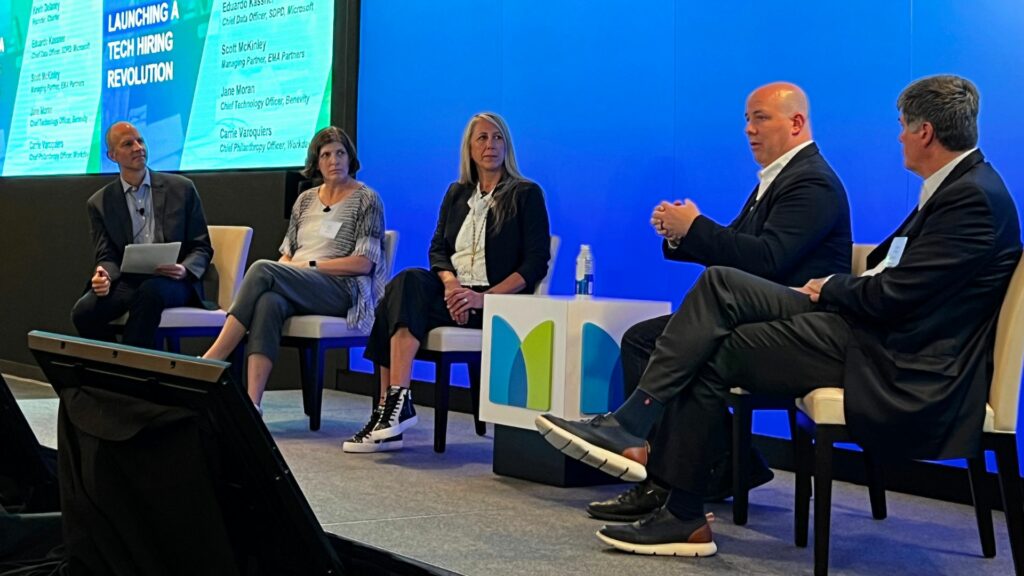A recent scan of job postings around the county shows that 92% of open jobs require some type of digital skill. That’s across all industries, not just the tech industry.

It’s well documented that employers are having a hard time finding workers with the skills needed to fill those jobs, especially for entry-level positions.
As a result, says Generation founding global CEO Mona Mourshed, entry-level jobs are disappearing.
“If you come from an underrepresented community anywhere in the world and you’re able to access an entry-level tech job, what that means in terms of the wage implication, in terms of the promotion opportunity, it can literally lift your life onto a different economic trajectory,” she explains.
The global nonprofit Generation has taken a closer look at the problem and what can be done to close that hiring gap and put people onto the pathway to economic mobility.
Its conclusions are available in the new report Launching a Tech Hiring Revolution and were the subject of a panel discussion Monday in New York.
Barriers to Building a Entry-Level Tech Workforce
The report surveyed thousands of job seekers in the U.S. and seven other countries and found there is a disconnect between how employers are going about sourcing tech talent, despite some investment in entry level talent pipelines through methods like onboarding, mentorship, and internship programs.
“Despite these intentions, employers are struggling. More than half of employers surveyed (52%) say their company is finding it difficult to hire for entry-level tech positions,” states the report.
One of the problems, the report continues, might be that over the past three years 61% of employers in the global survey have added education- or experience-related hiring requirements, citing a need for greater efficiency in the hiring process. That seems to have backfired on the employers and job seekers.
About a third of unsuccessful applicants for tech roles (31%) say they were unable to meet those requirements and progress to the next recruiting stage.
“You must have previous work experience, and that is often six months or a year or more. So, how can you get started if you can’t get started? The vast majority of those entry-level jobs require you to have a bachelor’s, a STEM background,” explains Mourshed. “That’s across the world and that’s across the sectors. The entry-level job has essentially disappeared for 94% of the entry-level roles.”
She adds, “that’s the first implication. But the thing is, for those employers who actually engaged in raising education and work experience requirements, life didn’t get better for them.”
The report concludes, “to repair tech’s broken job ladder, employers should radically rethink how they approach the very first rung.” The encouraging news is a majority of employers (62%) agree that the recruitment processes for entry-level roles need to change.
Refining the Skills-Based Hiring Approach
Generation suggests that the answer is refinement of the skills-based hiring approach.
The report offers these findings as evidence:
- 58% of the companies that removed at least one degree or work experience requirement saw an increase in the number of applicants, allowing them to hire more candidates more quickly. In addition, opening up new talent pools increases the odds of bringing in diverse talent.
- 84% of the companies indicate that candidates they hired after redefining requirements performed just as well on the job, if not better, than those hired under more stringent requirements.
- Further, employers that redefined requirements are spending less. Their counterparts who added requirements spend 13% more than those who removed them.
Generation and its panel of experts at the presentation had a number of suggestions on how this approach can be scaled up to help fill the global tech hiring shortage.
- At the start of hiring, remove work experience and degree requirements and use certifications and other skills indicators to increase applicant pools.
- During the hiring process, use technical assessments to ensure applicants have the necessary skills for the job.
- Throughout the process, pay attention to behavioral skills as well as technical capabilities.
- Broaden your recruiting team to reduce tacit bias and bring in a wider range of diverse talent.

The report – produced with the support of The HG Foundation; Bank of America; Clayton, Dubilier, and Rice; and MetLife Foundation – goes into greater detail on how to achieve these goals.
Read the full report here: Launching a Tech Hiring Revolution











